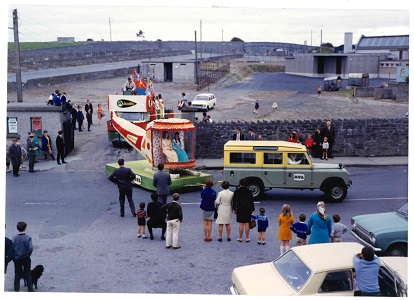ST. PATRICK’S DAY PARADES OF YESTERYEAR

by Tom Kenny
St. Patrick may never have made it to Galway, I could not find any legend that associates him with the city, except maybe for those anyone who went to Athenry to get their arse painted green. The anniversary of the saint’s death has been celebrated for many generations and the central focus of the day was usually the parade.
In 1912, many sections of society took part in the procession and they were divided into eight sections: 1. Language and Civic Authorities including the Gaelic League; 2. Temperance and Benefit Societies; 3. College and Secondary Schools; 4. Trades, Labour and commerce groups; 5. The Gaelic Athletic Association; 6. Political groups including AOH and Sinn Féin; 7. Schools, including the Industrial School; 8. Local Industries. The route took participants from Eyre Square down Shop Street, Dominick Street, Henry Street, Newcastle Road, University Road, the Salmon Weir Bridge to the Courthouse/Town Hall, where it finished.
Music was supplied by the Galway Piper’s Band, the Industrial School Band, the Claregalway Fife and Drum band and St. Patrick’s Brass and Reed Band who had played for every other previous parade from 1903 as a fife and drum band. This latter band was originally formed in 1896 as a fife and drum band and their playing ‘added to the brilliance of the procession with their new uniforms and instruments’. After the parade, there were football, hurling, handball and athletic games organised in town and that night there was a concert in the Town Hall. The Galway Express noted that there was not a single case of drunkenness to be seen during the day, that in years prior to 1903, “the chief characteristic of the native of the soil was to ‘drown the shamrock’ and the town saw rows and faction fights throughout the day”. This last sentence would seem to suggest that the first St. Patrick’s Day parade in Galway was in 1903.
Many of the above mentioned outfits were also there for the 1916 parade, but this one was dominated by 617 marching Volunteers, many of them armed, made up of Irish National Volunteers drawn almost solely from the city, and Irish Volunteers all of whom came from the County. They were all ‘well-mannered while in the city’. This represented a serious show of force to the authorities before the Rising.
If you ask any Galwegian who participated in or watched parades in the fifties they will almost certainly say that what they remember is being ABSOLUTELY FROZEN. For many it was more of a torture than a pleasure. It was during Lent and yet huge crowds turned up every year. Whatever the weather, many of the schoolboys were made to march in shirt sleeves, often with layers of vests underneath to protect them from the cold. Many of the girls marched in first communion dresses or Irish dancing costumes and had to wear ‘dynamite tights’ to keep themselves warm.

What the spectators saw in those parades was a lot of army and FCA personnel, nurses, Order of Malta, Red Cross, St. John’s Ambulance, dancing schools, GAA clubs, UCG staff and students, the only real entertainment came from the Army Pipe Band, The Industrial School Band, The Guth-na-n-Óg pipe band and St. Patrick’s Brass band. There was usually a long line of commercial vehicles at the end, vans and flat top trucks showing off their company names. That section was boring. Some of the groups parked their transport at the Fairgreen as the parade finished in the Square, but they all assembled on Fr. Griffin Road for the start and the parade made its way up through the town.
The things began to change, floats joined the parade featuring performing groups such as the Bohermore or Claddagh residents, school bands representing Renmore, Shantalla the Claddagh and St. Pat’s livened things up, American bands arrived and then of course, the cultural phenomenon Macnas changed everything even more.
In the days leading up to the feast you were often sent out in the fields looking for shamrock. It was a day off school which was not to be sneezed at and also a holy day so most people went to mass which was often celebrated in Irish. Most wore shamrocks or little cloth tricolours on their lapel as they listened to hymns like “Hail Glorious St. Patrick”. The collection always for Connradh na Gaeilge and you would hear more Irish than usual on the streets. Then followed the parade after which many like to ‘wet the shamrock’ rather than drown it. The Railway Cup finals were broadcast in the afternoon and dinner that day was usually bacon and cabbage.
Our photographs today show the Mary Rita O’Donnell School of dancing on their way to the parade in 1959 and secondly, an ESB Float and a Jacob’s Biscuits float leaving the Fairgreen on their way to join the parade c.1965.
This year, Galway Corporation have lined up an impressive series of events in addition to the parade around the holiday. There is a free three-day musical festival taking place in Eyre Square featuring an array of local musicians including youth band and established groups. Árdán will have an outdoor screening of short films in the Fishmarket at 2pm on the 17th: Pálas Cinema Bar and the Silent Cinema in Dominick Street will host a walk in exhibition of the early silent films of Ireland on the 17th and 18th; There will be a family fun sports day in Salthill Park and on the Prom starting at 12 noon on Sunday the 19th. You can check details on the website galwaycity.ie
.png)